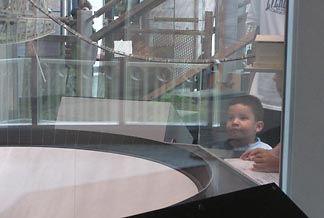Puerto Rican students, teachers, families learn from Arecibo scientists
By Lauren Gold

Nobody just happens to be driving by the Arecibo Observatory. The road is miserable. The drivers are worse.
So it might seem that José Alonso's job -- teaching young people, teachers and other visitors about the telescope's scientific value -- would be daunting.
But Alonso (nobody calls him Dr. Alonso, though he does have a Ph.D. in astronomy) likes a challenge. And this one suits him perfectly; even though he has to navigate the observatory road twice a day to do it.
If you have any doubts, just stop by the observatory's Angel Ramos Foundation Visitor and Educational Facility (if trudging up a long, steep hill in sweltering tropical-summer heat is stopping by) and check out the crowds browsing the exhibits.
In the afternoons, they are composed of families -- children and parents and grandparents, young couples and teenagers. The mornings, during the school year, are devoted to classes from schools around the island. Two or three schools' worth visit every day, composed of children with notebooks and a list of questions in hand, free to explore the place until they have found the answers.
World-class science goes on every day at Arecibo. But the observatory is also a unique and natural source for Puerto Rican students and teachers. So besides overseeing the daily visits, Alonso and Daniel Altschuler, director of the Office for the Public Understanding of Science (and formerly the observatory's director) run dozens of programs focused on improving science education across the island.
Students can participate in the observatory's yearlong Arecibo Geoscience Diversity Project, a collaborative effort between the National Astronomy and Ionosphere Center at Cornell, which operates the observatory for the National Science Foundation, and the University of Puerto Rico, giving high schoolers and teachers a chance to work on environmental and atmospheric science projects. Or students can come to various workshops -- like a recent one on how to use graphing calculators.
Meanwhile, science teachers at all levels come for seminars and intensive summer training in science education. And university students from across the island participate in internships and work at the Visitor Center.
Arecibo's outreach programs focus on astronomy, but they are not constrained by it. "One topic limits the possibilities," says Alonso. "I look at science in a much broader perspective."
He adds: "There is a tremendous need in Puerto Rico for people who can help in science education. Our students were not performing on the level they should. But the Puerto Rico economy has moved into the high-tech domain. You need to have a good background in sciences so you can be an important part of the high-tech world.
As a native Puerto Rican, he feels lucky for the opportunity to make a difference. Especially here, at the biggest single-dish radio telescope in the world.
"The fact that I am an astronomer; it's like a musician getting to work for a symphony. It's a privilege that few of us get to do.
"It's like writing poetry," Alonso says. "That's important for the soul."
Media Contact
Get Cornell news delivered right to your inbox.
Subscribe